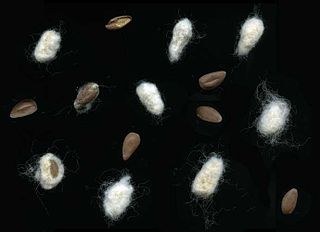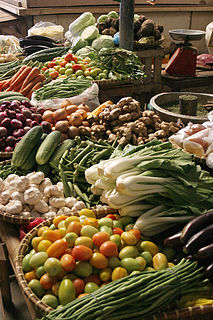Related Research Articles
A preservative is a substance or a chemical that is added to products such as food products, beverages, pharmaceutical drugs, paints, biological samples, cosmetics, wood, and many other products to prevent decomposition by microbial growth or by undesirable chemical changes. In general, preservation is implemented in two modes, chemical and physical. Chemical preservation entails adding chemical compounds to the product. Physical preservation entails processes such as refrigeration or drying. Preservative food additives reduce the risk of foodborne infections, decrease microbial spoilage, and preserve fresh attributes and nutritional quality. Some physical techniques for food preservation include dehydration, UV-C radiation, freeze-drying, and refrigeration. Chemical preservation and physical preservation techniques are sometimes combined.

Lignite, often referred to as brown coal, is a soft, brown, combustible, sedimentary rock formed from naturally compressed peat. It has a carbon content around 25 to 35 percent, and is considered the lowest rank of coal due to its relatively low heat content. Lignite is mined all around the world and is used almost exclusively as a fuel for steam-electric power generation.

Dietary fiber or roughage is the portion of plant-derived food that cannot be completely broken down by human digestive enzymes. Dietary fibers are diverse in chemical composition, and can be grouped generally by their solubility, viscosity, and fermentability, which affect how fibers are processed in the body. Dietary fiber has two main components: soluble fiber and insoluble fiber, which are components of plant foods, such as legumes, whole grains and cereals, vegetables, fruits, and nuts or seeds. A diet high in regular fiber consumption is generally associated with supporting health and lowering the risk of several diseases.

The avocado, a tree likely originating from south-central Mexico, is classified as a member of the flowering plant family Lauraceae. The fruit of the plant, also called an avocado, is botanically a large berry containing a single large seed. Avocado trees are partially self-pollinating, and are often propagated through grafting to maintain predictable fruit quality and quantity.

Saccharin is an artificial sweetener with effectively no food energy. It is about 300–400 times as sweet as sucrose but has a bitter or metallic aftertaste, especially at high concentrations. Saccharin is used to sweeten products such as drinks, candies, cookies, and medicines.

Guacamole (Spanish: [ wakaˈmole]; is an avocado-based dip, spread, or salad first developed in Mexico. In addition to its use in modern Mexican cuisine, it has become part of international and American cuisine as a dip, condiment and salad ingredient.

Cottonseed oil is cooking oil from the seeds of cotton plants of various species, mainly Gossypium hirsutum and Gossypium herbaceum, that are grown for cotton fiber, animal feed, and oil.

Borage, also known as a starflower, is an annual herb in the flowering plant family Boraginaceae. It is native to the Mediterranean region, and has naturalized in many other locales. It grows satisfactorily in gardens in most of Europe, such as Denmark, France, Germany, and the United Kingdom, remaining in the garden from year to year by self-seeding. The leaves are edible and the plant is grown in gardens for that purpose in some parts of Europe.The plant is also commercially cultivated for borage seed oil extracted from its seeds. The plant contains pyrrolizidine alkaloids, some of which are hepatotoxic, mutagenic, and carcinogenic.
Humic substances are organic compounds that are important components of humus, the major organic fraction of soil, peat, and coal. For a long era in the 19th and 20th centuries, humic substances were often viewed through a lens of acid–base theory that described humic acids, as organic acids, and their conjugate bases, humates, as important components of organic matter. Through this viewpoint humic acids were defined as organic substances extracted from soil that coagulate when a strong-base extract is acidified, whereas fulvic acids are organic acids that remain soluble when a strong-base extract is acidified.

Carminic acid (C22H20O13) is a red glucosidal hydroxyanthrapurin that occurs naturally in some scale insects, such as the cochineal, Armenian cochineal, and Polish cochineal. The insects produce the acid as a deterrent to predators. An aluminum salt of carminic acid is the coloring agent in carmine, a pigment. Natives of Peru had been producing cochineal dyes for textiles since at least 700 CE. Synonyms are C.I. 75470 and C.I. Natural Red 4.

Adiponitrile is the organic compound with the formula (CH2)4(CN)2. This dinitrile, a viscous, colourless liquid, is an important precursor to the polymer nylon 66. In 2005, about one million tonnes were produced.

2-Ethylhexanol is a branched, eight-carbon chiral alcohol. It is a colorless liquid that is poorly soluble in water but soluble in most organic solvents. It is produced on a massive scale (>2,000,000,000 kg/y) for use in numerous applications such as solvents, flavors, and fragrances and especially as a precursor for production of other chemicals such as emollients and plasticizers. It is encountered in plants, fruits, and wines. The odor has been reported as "heavy, earthy, and slightly floral" for the R enantiomer and "a light, sweet floral fragrance" for the S enantiomer.

Vegetables are parts of plants that are consumed by humans or other animals as food. The original meaning is still commonly used and is applied to plants collectively to refer to all edible plant matter, including the flowers, fruits, stems, leaves, roots, and seeds. An alternate definition of the term is applied somewhat arbitrarily, often by culinary and cultural tradition. It may exclude foods derived from some plants that are fruits, flowers, nuts, and cereal grains, but include savoury fruits such as tomatoes and courgettes, flowers such as broccoli, and seeds such as pulses.

Avocado oil is an edible oil extracted from the pulp of avocados, the fruit of Persea americana. It is used as an edible oil both raw and for cooking, where it is noted for its high smoke point. It is also used for lubrication and in cosmetics.

Fulvic acids are a family of organic acids, natural compounds, and components of the humus. They are similar to humic acids, with differences being the carbon and oxygen contents, acidity, degree of polymerization, molecular weight, and color. Fulvic acids remain in solution after removal of humic acid from humin by acidification.

The tomato is the edible berry of the plant Solanum lycopersicum, commonly known as a tomato plant. The species originated in western South America and Central America. The Nahuatl word tomatl gave rise to the Spanish word tomate, from which the English word tomato derived. Its domestication and use as a cultivated food may have originated with the indigenous peoples of Mexico. The Aztecs used tomatoes in their cooking at the time of the Spanish conquest of the Aztec Empire, and after the Spanish encountered the tomato for the first time after their contact with the Aztecs, they brought the plant to Europe. From there, the tomato was introduced to other parts of the European-colonized world during the 16th century.

Pittosporum tobira is a species of sweet-smelling flowering plant in the pittosporum family Pittosporaceae known by several common names, including Australian laurel, Japanese pittosporum, mock orange and Japanese cheesewood. It is native to Japan, China, Taiwan, and Korea, but it is used throughout the world as an ornamental plant in landscaping and as cut foliage.

A genetically modified tomato, or transgenic tomato, is a tomato that has had its genes modified, using genetic engineering. The first trial genetically modified food was a tomato engineered to have a longer shelf life, but never made it to market. The first direct consumption tomato was approved in Japan in 2021. Primary work is focused on developing tomatoes with new traits like increased resistance to pests or environmental stresses. Other projects aim to enrich tomatoes with substances that may offer health benefits or be more nutritious. As well as aiming to produce novel crops, scientists produce genetically modified tomatoes to understand the function of genes naturally present in tomatoes.

Bifenox is the ISO common name for an organic compound used as an herbicide. It acts by inhibiting the enzyme protoporphyrinogen oxidase which is necessary for chlorophyll synthesis.

Litsea garciae, also known as engkala, kalangkala, kangkala, medang, pangalaban, ta'ang, malai, wuru lilin, kelimah, bua talal, kelime, kelimie, bua' vengolobon, wi lahal, kelima, mali, beva' mali, kayu mali, malei, pengalaban, pengolaban, kupa, pipi, bagnolo, lan yu mu jiang zi, lan yu mu, buah tebuluh, tebulus, pong labon, and Borneo avocado, is a flowering tree in the family Lauraceae.
References
- 1 2 "Definition of POLYURONIDE". www.merriam-webster.com. Retrieved 2021-03-15.
- ↑ "Polyuronides - an overview | ScienceDirect Topics". www.sciencedirect.com. Retrieved 2021-03-15.
- ↑ Huber, D. J.; O'Donoghue, E. M. (June 1993). "Polyuronides in Avocado (Persea americana) and Tomato (Lycopersicon esculentum) Fruits Exhibit Markedly Different Patterns of Molecular Weight Downshifts during Ripening". Plant Physiology. 102 (2): 473–480. doi:10.1104/pp.102.2.473. ISSN 0032-0889. PMC 158801 . PMID 12231835.
- ↑ Nevenzel, Judd Cuthbert (1942). "The isolation and analysis of polyuronide materials from the barrel cacus, Echinocactus wislizenii".Cite journal requires
|journal=(help)